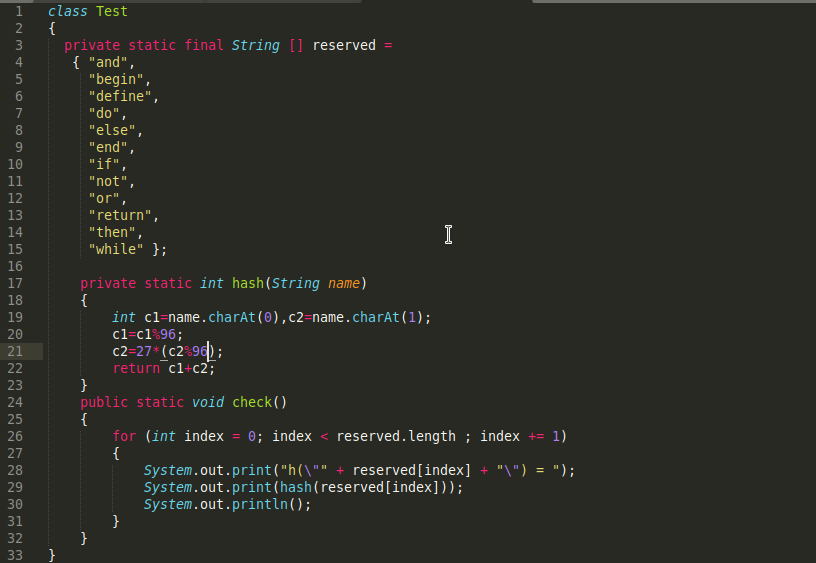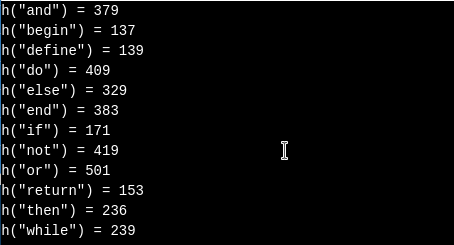Question
In: Computer Science
0. Introduction. This laboratory assignment involves designing a perfect hash function for a small set of...
0. Introduction.
This laboratory assignment involves designing a perfect hash function for a small set of strings. It demonstrates that a perfect hash function need not be hard to design, or hard to understand.
1. Theory.
We’ll start by reviewing some terminology from the lectures. A
hash function is a function that takes a key as
its argument, and returns an index into an array. The array is
called a hash table. The object that appears at the index
in that array is the key’s value.The key’s value is
somehow associated with the key.
A hash function may return the same
index for two different keys. This is called a collision.
Collisions are undesirable if we want distinct values to be
associated with distinct keys. A hash function that has no
collisions for a set of keys is said to be perfectfor that
set. Note that a hash function may be perfect for some sets of
keys, but not perfect for others.
Most modern programming languages
use a small set of reserved names as operators,
punctuation, and syntactic markers. (They’re also called
reserved words or keywords.) For example, Java
currently uses reserved names like if, private, while, etc.
A compiler for a programming
language must be able to test if a name in a program is reserved.
Programs may be hundreds or thousands of pages long, and may
contain thousands or even millions of names. As a result, the test
must be done efficiently. It might be implemented using a hash
table and a perfect hash function.
Here’s how the test may work.
Suppose that the hash table T is an array of strings. Each
time the compiler reads a name N, it calls a perfect hash
function h to compute an index h(N). If
h(N) is a legal index for T, and
T[h(N)] = N, then the name is
reserved, otherwise it is not. Unused elements of T might
be empty strings "". If we measure the efficiency of a test by the
number of string comparisons it performs, then the test requires
only O(1) comparisons. Of course this works only if
h is perfect for the set of reserved names.
Now suppose there is a very simple
programming language that uses the following set of twelve reserved
names.
|
and |
else |
or |
|
begin |
end |
return |
|
define |
if |
then |
|
do |
not |
while |
We might define a perfect hash function for the reserved names
in the following way. We get one or more characters from each name.
Then we convert each character to an integer. This is easy, because
characters are already represented as small nonnegative integers.
For example, in the ASCII and Unicode character sets, the
characters 'a' through 'z' are represented as the integers 97
through 122, without gaps. Finally, we do some arithmetic on the
integers to obtain an index into the hash table. We choose the
characters, and the arithmetic operations, so that no two reserved
names result in the same index.
For example, if we define the hash
function h so that it adds the first and second characters
of each name, we get the following indexes.
|
h("and") |
= |
207 |
|
h("begin") |
= |
199 |
|
h("define") |
= |
201 |
|
h("do") |
= |
211 |
|
h("else") |
= |
209 |
|
h("end") |
= |
211 |
|
h("if") |
= |
207 |
|
h("not") |
= |
221 |
|
h("or") |
= |
225 |
|
h("return") |
= |
215 |
|
h("then") |
= |
220 |
|
h("while") |
= |
223 |
This definition for h does not result in a perfect hash function, because it has collisions. For example, the strings "and" and "if" result in the index 207. Similarly, the strings "do" and "end" result in the index 211. We either didn’t choose the right characters from each string, or the right operations to perform on those characters, or both. Unfortunately, there is no good theory about how to define h. The best we can do is try various definitions, by trial and error, until we find one that is perfect.
2. Implementation.
Design a perfect hash function for the reserved names shown in the previous section. To do that, write a small test class, something like this, and run it with various definitions for the function hash. It calls hash for each reserved name, and writes indexes to standard output.
class Test
{
private static final String [] reserved
=
{ "and",
"begin",
"define",
"do",
"else",
"end",
"if",
"not",
"or",
"return",
"then",
"while" };
private static int hash(String name)
{
// Your code goes
here.
}
public static void main(String []
args)
{
for (int index = 0; index <
reserved.length ; index += 1)
{
System.out.print("h(\"" +
reserved[index] + "\") = ");
System.out.print(hash(reserved[index]));
System.out.println();
}
}
}
When defining hash, you might try adding characters at specific
indexes from each name. You might try linear combinations of the
characters: that is, multiplying the characters by small constants,
then adding or subtracting the results. You might try the operator
%. You might also try a mixture of these. Whatever you try, reject
any definition of hash that is not perfect: one that returns the
same index for two different names.
Your method hash must work in
constant time, without loops or recursions. It must not use if’s or
switch’es. It must not call the Java method hashCode, because that
uses a loop, and so does not work in O(1) time. It must
not return negative integers, because they can’t be array
indexes.
The character at index k in
name is obtained by name.charAt(k). Characters in Java
Strings are indexed starting from 0, and ending with the length of
the string minus 1. For example, the first character from name is
returned by name.charAt(0), the second character by name.charAt(1),
and the last character by name.charAt(name.length() - 1).
Don’t worry if there are gaps
between the indexes: your hash function need not be
minimal. Also, try to keep the returned indexes small:
they shouldn’t exceed 2000. For example, I know a perfect hash
function for the reserved words in this assignment, whose indexes
range from 1177 to 1413. I found it after about ten minutes of
trial-and-error search.
Solutions
Expert Solution
In these reserved words, no two words have both its first and second character as same. So we will write a method in which it will output different index as long as both the first and second character of two words are not same.
c1=name.charAt(0),c2=name.charAt(1);
c1=c1%96;
c2=27*(c2%96);
result <= c1+c2;
Code Screenshot:



Code:
class Test
{
private static final String [] reserved =
{ "and",
"begin",
"define",
"do",
"else",
"end",
"if",
"not",
"or",
"return",
"then",
"while" };
private static int hash(String name)
{
int c1=name.charAt(0),c2=name.charAt(1);
c1=c1%96;
c2=27*(c2%96);
return c1+c2;
}
public static void check()
{
for (int index = 0; index < reserved.length ; index += 1)
{
System.out.print("h(\"" + reserved[index] + "\") = ");
System.out.print(hash(reserved[index]));
System.out.println();
}
}
}
public class Main
{
public static void main(String [] args){
Test test = new Test();
test.check();
}
}
Related Solutions
0. Introduction. This laboratory assignment involves implementing a data structure called a map. A map associates...
This laboratory assignment involves implementing a data structure called a map. A map associates objects called...
0. Introduction. In this assignment you will implement a stack as a Java class, using a...
Prove that the function defined to be 1 on the Cantor set and 0 on the...
0. Introduction. In this lab assignment, you will extend some simple Java classes that represent plane...
EENG 1910: Project I – Introduction to Electrical Engineering Assignment-8 1. Create a MATLAB function that...
An undamped spring - mass system with mass m = 2 and a spring constant k = 8 is suddenly set in motion at time t = 0 by an external force f = 5 cos 3t . Determine the position of the mass as a function of time and draw the graph .
- Bonita Cole Inc. acquired the following assets in January of 2015. Equipment, estimated service life, 5...
- Accoring to the equation: AssO3 + 3C = 3CO +2As the reaction of 1gmol of AssO3...
- Create a program in Visual studio c++ Frank wants to take his wife, son, and daughter...
- Please show Each Formula and Each Step used to obtain the answer(s). How many 18 Watt...
- 1. Draw the money market with the value of money on the vertical axis and the...
- Even organizations as large and successful as State Farm Insurance have to plan for the future....
- Q. WHAT IS THEORY X AND THEORY Y? Q. IF YOU HAD YOUR OWN COMPANY, WOULD...
 venereology answered 2 months ago
venereology answered 2 months ago